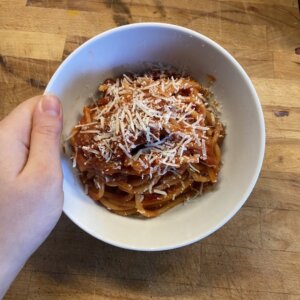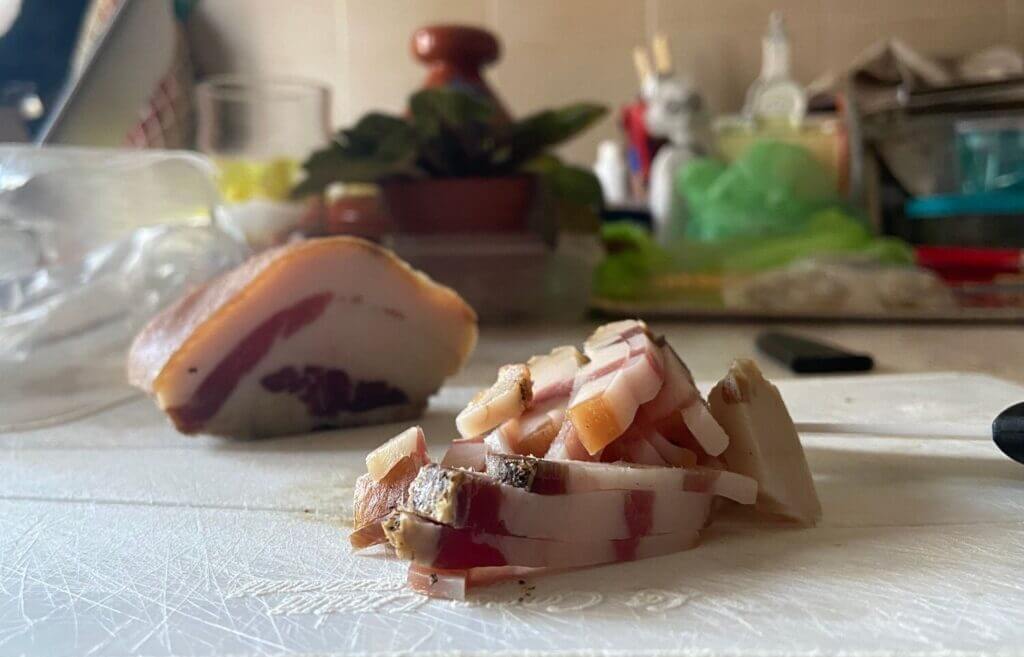Traditional Roman Holiday #1 – Pasta All’Amatriciana
One of the three Roman staples, pasta all’amatriciana (pronounced allah-mah-tree-chee-ana, some support here for when you’ll finally go to Rome) is so easy that I was about to call this post “Stupid Easy Amatriciana”, but I thought that would have been a bit too much. Often overlooked by its more famous sister, the worldwide-butchered carbonara, this dish still holds a special spot in Italian hearts.
Personally, we’re more partial to a tomato-base sauce, and amatriciana tends to be lighter (as much as a pasta with guanciale can be) than the egg-based carbonara, so it’s usually our go to.
If you just started to venture in the world of Italian cooking and are finally leaving ready-made sauce in the supermarket shelves where they belong, amatriciana is an excellent starting point. It’s very easy to make once you get the right ingredients (a note on that and where to find them after the recipe, we’re hungry at this point). Win-win.

Pasta all’Amatriciana
Equipment
- Saucepan
- Medium Pot to Boil Water
- Collander/Pasta Drainer
- Chef's Knife
- Grater
Ingredients
- 200 gr guanciale (pork cheek/pig jowl)
- 400 gr chopped or diced tomatoes (1 can)
- 150 gr pecorino (grated)
- 1/2 tsp chilli powder
- 400 gr pasta
- 1/2 glass dry white wine (optional, see notes)
Instructions
- Slice or dice the guanciale (careful: not too thin otherwise you risk to burn it) and add it to a hot pan. No need for any oil as it's going to cook in its own fat. Make sure to use a low flame and take it out when the fat gets translucent and the meaty part looks nice and golden, it should be slightly crunchy. The whole process should take less than 10' depending on how thick/thin you cut it.
- Once the guanciale has been taken out, you can add the canned tomatoes and the chilli powder – I used tomato sauce in lack of a better alternative but diced or chopped canned tomatoes work better. Cook it with the fat that was left in the pan for 15' on a low flame (20' if you're using tomato sauce) until it reduces a bit. Taste to check if you need to add salt. You can start boiling the water for your pasta (don't forget to salt it!) while you let the tomatoes cook.
- Take half of your grated pecorino and add it to the sauce, mix, and let it cook for another couple of minutes. At this point, you should be cooking your pasta.
- Once the pasta is done and it's properly al dente, add it to the pan and mix. Add the cooked guanciale you took out earlier and add the remaining grated pecorino on top. Ready to be served!
While you sip your glass of Lambrusco…
Some people like to add wine to their amatriciana sauce. Without getting into the whole debate, if you want to add some wine, you should do so while the guanciale is still cooking.
Use half glass of dry white wine while the guanciale is getting crispy to deglaze. For this step, you’d want to raise that flame a bit, but be careful to not burn the guanciale – and wait for the wine to be completely evaporated before you add the tomatoes!
Some people will claim that amatriciana must have some wine. Other will say that historically, it sounds unlikely that they were adding wine to it and it’s clearly a modern adaptation. A third group might come here and say that it should be red wine, not white. As for all traditional recipes, everyone has its own version so don’t think too much about it. Or, even better, test them all and pick your version!
A note on guanciale for your amatriciana
So you might ask, why guanciale? Is bacon not the same? It’s not. In the same way a chicken thigh is not the same as a chicken breast: they’re different parts. The same is valid for pancetta of course, so don’t try and cheat with that – just because it has an Italian name, doesn’t mean it works. Can you substitute guanciale with bacon? You sure can, but that won’t be an amatriciana, but a possibly very tasty tomato sauce with bacon bits.
Also, how could you say no to this lovely piece of guanciale?

A second note on pecorino
I really don’t want to be the Italian cliche pointing fingers. However, this is exactly what I’m going to do. First things first: pecorino is not parmesan. I just want to make this clear before we go any further. A lot of people believe that the two are interchangeable, but that’s definitely not the case!
To put it in simple terms, pecorino is a bit of a diva. A strong, confident diva. We can call it the frontman of a band. It mixes well with others, but it wants to have a prominent role in the scene. Parmesan is more like the drummer: definitely there, crucial for the overall success, but part of the bigger picture and with an occasional solo every once in a while.
Pecorino has definitely a stronger taste than parmesan and it’s made from sheep’s milk rather than cow’s. Because of this, you would need less pecorino than you’d need parmesan. Bare this in mind when you grate it for your pasta.
Where to find Italian ingredients
That said, after this brief italiansplanation, the main issue with using guanciale and pecorino is finding them when you live abroad. Now, if you’re not lucky enough to be invited to dinner at ours, where I tend to always have a stack in the fridge, you have a few alternatives:
- Italian delis: not all of them will have it so it might be a hit or miss; if you live in London, drop us a comment and I can share a few of our trusted ones, especially in North and South London.
- Italian produce e-commerces: there are so many of them even I can’t keep track; one of the most famous is Nife Is Life – the saviour of Italians in the UK — they offer a huge variety of Italian food at decent prices. Others are L’Isola Buona, Dolceterra, and Vorrei.
- Other online shops: for when I find myself not going back to Italy anytime soon, I make sure to have a good list of options to buy guanciale from for emergencies, including Kimber’s, and sometimes Ocado.
- If you’re in London and can’t find a nearby Italian deli and don’t want to wait for delivery, your best bet is to head over to Borough Market, and find the stall of Gastronomica. While you’re there you may as well buy everything else as well. (Literally, everything.) It’s my favourite stall in the market. It makes me feel like home and the produce they sell is absolutely amazing. (You can also buy online on their website.)
- If you’re outside of the UK, you still have a few alternatives. If you have delis, always try there first. In the US, obviously Italian-heavy communities like NYC and Boston will have some delis. Some Whole Foods locations have it, though others don’t. You can also try IGourmet, which has an impressive selection of Italian produce. You can also try Eatalian Food for Europe/Worldwide orders, although you might want to do a big bulky order on this one.
It goes without saying that if you need any help in buying Italian ingredients, you can always drop us a message and we’ll come to the rescue!
